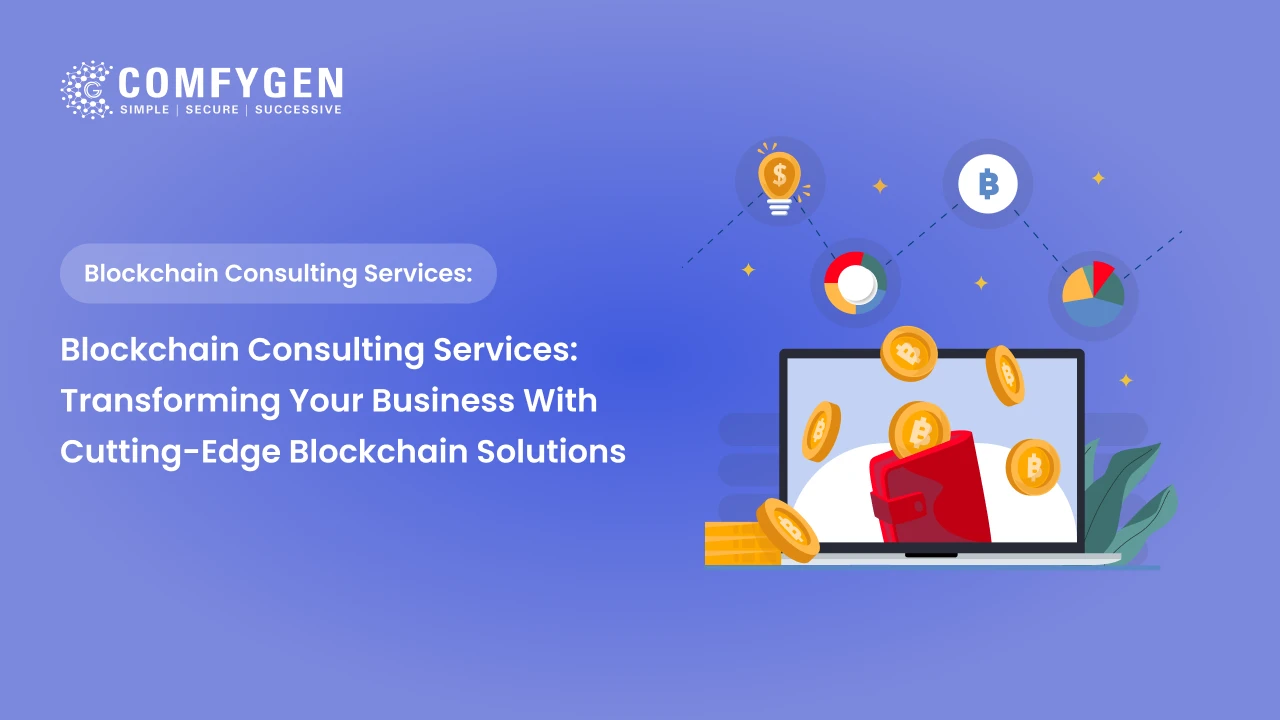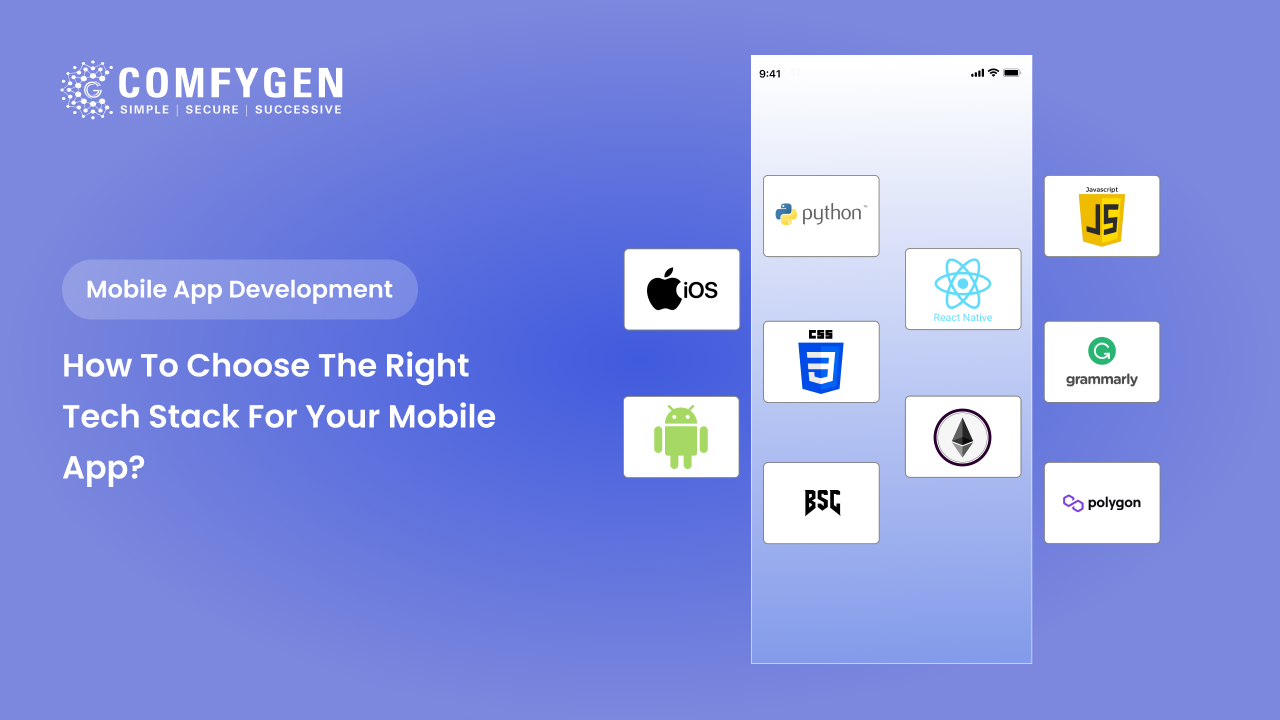How to Choose the Right Tech Stack for Your Mobile App?
Choosing the right technology stacks for mobile app development is very significant because that will make your application reliable, secure, and seamlessly operational. This blog will share information regarding the needed and right mobile app development tech stacks.
The appropriate technologies enable mobile applications to gain scalability by delivering high-performance and engaging user experiences. The combination of frontend frameworks, backend languages, cloud infrastructure, and databases determines how soon the app will hit the targeted market.
However, today mobile app developers prioritize React Native, Node JS, MongoDB, Firebase, Flutter, or Kotlin/Swift with AWS Microservices to build robust, performing applications.
This blog will take you through the technologies and strategic thinking behind choosing optimal tech stacks for your mobile app development. Thoroughly study the information and take the right practical decision framework that aligns with your business goals.
What is Mobile Tech Stack?
A mobile app tech stack refers to the group of programming languages, frameworks, libraries, tools, and technologies used to create and deploy a mobile application. Think of it as the digital ecosystem that supports every feature, user interaction, and performance metric of your app—from the UI your users touch, to the backend business logic that serves millions of requests per second.
Core Components of a Mobile App Tech Stack
1. Frontend (Client-Side)
This layer is what users interact with directly. For mobile apps, this typically means:
Native development: Swift for iOS, Kotlin/Java for Android
Cross-platform frameworks: React Native, Flutter, Xamarin—enabling a single codebase for both iOS and Android
2. Backend (Server-Side)
Handles business logic, data processing, authentication, and third-party integrations. Common backend technologies include:
Languages: Node.js, Python, Ruby, Java, PHP
Frameworks: Express.js, Django, Spring Boot, Laravel
3. Database
Stores and retrieves data efficiently. Choices depend on your app’s needs:
Relational: MySQL, PostgreSQL
NoSQL: MongoDB, Firebase Realtime Database, DynamoDB
4. APIs & Integrations
Allow your app to communicate with external services (payments, notifications, analytics, etc.), and enable modular, scalable architecture.
5. Cloud Services & DevOps
Support hosting, deployment, scaling, monitoring, and CI/CD pipelines. Popular options include AWS, Google Cloud, Azure, and tools like Docker, Kubernetes, and Jenkins.
Ready to Build
A High-Performance Mobile App?
Contact Now
Why is Choosing the Right Tech Stack Important?
Selecting the right tech stack is not just a technical decision—it’s a strategic business move that impacts every dimension of your mobile app’s lifecycle. The technologies you choose early on will dictate how your app performs under heavy user loads, how easily it integrates new features, and how efficiently it scales as your business grows.
Performance & User Experience
The responsiveness and reliability of your app are reliant on the tech stack you choose. Native stacks (Swift for iOS, Kotlin for Android) will give you the best performance and experience, cross-platform frameworks (like Flutter and React Native) will approach this with a faster development timeline, though with less user experience.
Scalability
If your app will be used by millions of users and/or if you’ll be processing real-time data, a scalable backend and flexible cloud environment are critical. The best stack must include the best way to scale as a user of your app grows, avoiding costly rebuilding as your user base expands.
Security & Compliance
A data breach or compliance breach can destroy your brand. The best stacks will provide the best user authentication, data encryption, and compliance with regulations (think GDPR, HIPAA), especially for fintech, health, and enterprise apps.
Development Speed & Cost
Some stacks are geared to build out a prototype or MVP (think Flutter + Firebase) in weeks, where other stacks will take considerably more time, but offer highly customizable roadmaps (native development). Finding the right balance will save your budget and time without sacrificing quality.
Maintenance & Future-Proofing
Technology evolves fast. Choosing a popular, well-supported stack ensures easier maintenance, a larger talent pool, and access to continuous updates, reducing the risk of your app becoming obsolete.
Third-Party Integrations
Today’s apps rarely exist in isolation. Whether it’s payment gateways, analytics, or IoT connectivity, your tech stack must support seamless third-party integrations to unlock the features users expect.
Competitive Advantage
Companies like Uber, Instagram, and WhatsApp became market leaders partly because of smart tech stack choices, which enabled rapid innovation, global scaling, and industry-defining performance.
Core Components of Mobile App Tech Stack
Choosing the right technology stacks for mobile app development is imperative. Every component plays a unique role in delivering seamless user experiences, robust performance, and agile scalability. Therefore, select the technology wisely:
Frontend (Client-Side) Technologies
This is what users see and interact with. Your choice here affects UI/UX, device compatibility, and overall app responsiveness.
Native Development
- iOS: Swift, Objective-C
- Android: Kotlin, Java
Cross-Platform Frameworks
- React Native: JavaScript-based, single codebase for iOS & Android
- Flutter: Dart-based, fast rendering & beautiful UIs
- Xamarin: C#-based, integrates with the Microsoft ecosystem
Backend (Server-Side) Technologies
The backend powers all the logic behind the scenes—handling authentication, business rules, data processing, and external integrations.
Popular Languages & Frameworks
- Node.js (JavaScript/TypeScript)
- Python (Django, Flask)
- Java (Spring Boot)
- Ruby on Rails
- PHP (Laravel, Symfony)
Key Responsibilities: User authentication & authorization, Business logic & workflows, Data synchronization (Communication with databases and APIs)
Database
Databases store, retrieve, and manage all persistent data for your app. Choice depends on data structure, scalability needs, and real-time requirements.
- Relational Databases: MySQL, PostgreSQL, SQL Server
- NoSQL Databases: MongoDB, Firebase Realtime Database, DynamoDB, Couchbase
- Cloud-Native Options: Google Firestore, AWS Aurora, Amazon RDS
APIs & Integrations
APIs enable your app to communicate with servers, third-party services, or other systems, extending your app’s capabilities.
- Types of APIs: RESTful APIs, GraphQL
- Common Integrations: Payment gateways (Stripe, PayPal), Social logins (Google, Facebook), Analytics (Firebase, Mixpanel), Push notifications (Firebase Cloud Messaging, OneSignal)
Cloud Services & DevOps
Cloud infrastructure supports app deployment, scalability, storage, and monitoring, while DevOps ensures smooth delivery and updates.
- Cloud Platforms: AWS, Google Cloud Platform (GCP), Microsoft Azure, DigitalOcean
- DevOps Tools: Docker, Kubernetes, Jenkins, GitHub Actions, Bitbucket Pipelines
- Services: CI/CD pipelines, auto-scaling, monitoring (Datadog, New Relic), serverless functions (AWS Lambda, Google Cloud Functions)
Security & Compliance Tools
Security is non-negotiable. Robust stacks incorporate encryption, secure authentication, data privacy, and compliance with standards (GDPR, HIPAA).
- Tools & Features: OAuth, JWT, SSL/TLS encryption, data masking, role-based access control
| Layer | Technologies | Examples |
| Frontend | Swift, Kotlin, React Native, Flutter, Xamarin | UI/UX, device compatibility, app logic |
| Backend | Node.js, Django, Spring Boot, Ruby on Rails | Logic, data processing, and user management |
| Database | PostgreSQL, MongoDB, Firebase, DynamoDB | Data storage, retrieval, and scalability |
| APIs | REST, GraphQL, Stripe, Firebase, Mixpanel | Integration, communication, analytics |
| Cloud/DevOps | AWS, GCP, Azure, Docker, Jenkins, Kubernetes | Hosting, deployment, scaling, and monitoring |
| Security | OAuth, JWT, SSL, RBAC, and GDPR tools | App/data security, compliance |
Types of Mobile Apps & How They Influence Tech Stack Choices
The technology stack you select is influenced by many things— not all mobile apps are alike, and your app’s category, complexity, and the platforms you want to target will all play an important role in, so understanding the different app types will help you align your requirements to the best technology stack for lasting success.
Native Mobile Apps
Built specifically for a single platform (iOS or Android) using that platform’s primary languages and SDKs (e.g., Swift for iOS, Kotlin for Android).
Tech Stack Characteristics:
- Highest performance and responsiveness
- Full access to device features (camera, GPS, sensors)
- Platform-specific design and UX
- Longer development cycle if targeting both iOS & Android
Best For: Apps demanding top-tier performance, intensive graphics, real-time features (e.g., gaming, AR/VR, fintech, social media platforms).
Cross-Platform Mobile Apps
Developed using frameworks that allow a single codebase to run on both iOS and Android.
Popular Frameworks: React Native, Flutter, Xamarin
Tech Stack Characteristics:
- Faster development and easier maintenance
- Close-to-native performance, though not always 100%
- Access to many (but not all) native device features via plugins or modules
- Unified UI/UX with minor platform tweaks
Best For: Startups, MVPs, and most business apps seeking faster go-to-market and lower costs.
Hybrid Mobile Apps
Combine web technologies (HTML5, CSS, JavaScript) within a native wrapper, allowing deployment on multiple platforms.
Popular Frameworks:
Ionic, Cordova, PhoneGap
Tech Stack Characteristics:
- Lower development costs and code reuse
- Limited access to device hardware (depends on plugins)
- Performance may lag behind native and modern cross-platform apps
Best For:
Content-driven apps, simple utility apps, or internal business tools.
Progressive Web Apps (PWAs)
Web applications optimized for mobile, which can be installed on devices and accessed via a browser, but function much like native apps.
Tech Stack Characteristics:
- Use web stacks (HTML5, CSS, JavaScript, Service Workers)
- No app store deployment required
- Limited access to advanced device APIs
- Fast updates and lower distribution friction
Best For:
Businesses aiming for maximum reach with minimum investment, or when app store presence isn’t critical.
How does This All Affect Your Tech Stack Decisions?
- Performance needs: High-performance, graphics-intensive applications are usually best suited with a native stack.
- Budget & timeline: Limited budgets and quick launches will often lead you toward cross-platform or hybrid solutions.
- User experience: For highly polished, platform-specific UX, native is the best option; for wide coverage, PWA or cross-platform are the best options.
- Scalability and Maintenance: Cross-platform frameworks make updates much simpler, while native applications require parallel development in each OS.
Confused About Which
Tech Stack Fits Your App Idea?
Contact Now
Key Factors to Consider When Choosing a Tech Stack
Choosing the right tech stack is a methodological process that goes beyond simply following trends or developer preference. A thoughtful decision requires a comprehensive analysis of your project’s unique requirements, long-term ambitions, and real-life limitations. Here are the most important considerations to keep in mind before concretizing your mobile app’s tech stack:
Project Requirements & Complexity
Feature Set
Apps with advanced functionalities (real-time chat, AR, offline mode) often demand more robust, specialized stacks.
App Type
Is your app native, cross-platform, hybrid, or a PWA? Each type has optimal tech stacks that match performance and UI needs.
Scalability & Performance Expectations
- User Load
- Plan for future growth—will your app need to support thousands or millions of users?
Processing Power
High-performance and real-time apps (e.g., fintech, gaming, streaming) need stacks that can handle heavy loads without lag.
Security & Compliance
- Data Protection
- Apps handling sensitive user data (finance, healthcare) require stacks with proven security practices, encryption, and secure authentication.
Regulations
Does your app need to comply with GDPR, HIPAA, or other standards? Choose stacks that simplify compliance management.
Time to Market
- Development Speed
- Startups and MVPs often prioritize rapid launches. Cross-platform stacks (like Flutter or React Native) can dramatically reduce timelines.
Prototyping
If you need quick user feedback, choose tools and frameworks that support agile iteration and fast prototyping.
Budget & Total Cost of Ownership
- Initial Development Cost
- Native stacks may cost more due to parallel development, while cross-platform or hybrid solutions are more budget-friendly.
Long-Term Maintenance
Consider future update costs, bug fixes, and ease of finding developers for your chosen stack.
Team Expertise & Resource Availability
- Skill Sets
- Leverage the current skills of your in-house team or consider the availability (and cost) of hiring talent for a new stack.
Community & Support
Established, well-supported stacks come with rich documentation, third-party libraries, and active developer communities.
Integration & Ecosystem
- Third-Party Services
- Will your app require payments, push notifications, analytics, or IoT integrations? Your stack should seamlessly support these needs.
Modularity
Opt for stacks that support modular development, making it easier to add or replace features in the future.
Future Maintenance & Upgrades
- Longevity
- Choose stacks that are actively maintained and updated—avoid technologies at risk of becoming obsolete.
Version Compatibility
Ensure your stack supports easy upgrades and migration paths as frameworks and OS versions evolve.
Final Verdict
When building a mobile app, it is essential to select the right technology stack so the app is reliable, scalable, and can be maintained into the future. The choices you make today with frontend and backend technology change the app’s performance, security, user experience, and ability to scale as the demand for your app grows. Mobile app development encompasses various technologies and is rapidly evolving, so it’s important to look past the hype and focus on proven technologies that have robust support by leading industry professionals and fit the project requirements and budget you set forth and your vision for the future.
Whether selecting React Native, Flutter, Kotlin, Swift, Node.js, or Firebase, make sure you base decisions on careful consideration of the app’s goals, users’ needs, and the competitive landscape of the market. The technology stacks you chose for the project will enable you to deliver high-performance applications, shorten the time it takes to get to market, and help you gain a competitive advantage. Investing time planning strategically and successfully evaluating your tech stack will allow you to deliver the best possible mobile app product that stands out from the rest in today’s ocean of digital engagement.

Mr. Saddam Husen, (CTO)
Mr. Saddam Husen, CTO at Comfygen, is a renowned Blockchain expert and IT consultant with extensive experience in blockchain development, crypto wallets, DeFi, ICOs, and smart contracts. Passionate about digital transformation, he helps businesses harness blockchain technology’s potential, driving innovation and enhancing IT infrastructure for global success.
Based on Interest

Blockchain Consulting Services: Transforming Your Business with Cutting-Edge Blockchain Solutions
Introduction Blockchain technology is revolutionizing industries by providing secure, decentralized, and transparent solutions. As businesses across the world explore their potential,…








